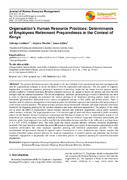| dc.contributor.author | Gathiira, Githaiga | |
| dc.contributor.author | Muathe, Stephen | |
| dc.contributor.author | Kilika, James | |
| dc.date.accessioned | 2020-10-22T08:54:27Z | |
| dc.date.available | 2020-10-22T08:54:27Z | |
| dc.date.issued | 2020-07 | |
| dc.identifier.citation | Journal of Human Resource Management 2020; 8(3): 152-162 | en_US |
| dc.identifier.issn | 2331-0707 | |
| dc.identifier.issn | 2331-0715 | |
| dc.identifier.uri | https://karuspace.karu.ac.ke/handle/20.500.12092/2441 | |
| dc.description | doi: 10.11648/j.jhrm.201200803.16 | en_US |
| dc.description.abstract | The premise that human resource (the people) is the most valuable of all organizational resources presupposes the
need for organizational strategies to secure the future of both the organization and employees. The role played by employer
organizations in employee separation planning is imperative in providing insight into the human resource practices geared
towards employees’ eventual retirement. However, separation decisions are ignored in theory and practice, and even the little
attempts made has inherent weaknesses. This has left employees’ retirement planning being a concern of individuals just about
to retire or otherwise plunging into retirement life without planning at all. Separation planning predicts higher levels of
individual’s postretirement adjustment across various occupational settings in both public and private sectors. There is
therefore need for judicious management of retirement transition by individual employees and employers through promotion of
sound human resource practices. The human resource practices should intentionally influence individual employee’s retirement
behaviours by triggering planning for the eventual separation and hence retirement preparedness. The purpose of this study
was to assess the effect of organization’s human resource practices and retirement preparedness among public secondary
school teachers’ in Kenya. The target population was 1,238 teachers aged 50 years and above, employed in public secondary
schools by the Teachers Service Commission in Kirinyaga and Murang’a Counties by 2017. A representative sample of 334
respondents was selected using multistage sampling technique. Data was collected using semi structured questionnaire and
interview guide. Logit regression was used to establish the relationships between variables in the study and to test hypotheses
at P ≤ 0.05 at 95% confidence level. The study found that human resource practices influence retirement preparedness
positively. The study therefore concluded that sound HR practices should be put in place by the employer organizations to offer
conducive environment that make employee separation planning and retirement preparedness possible. The study
recommended the government through its agencies and/or Commissions to enact frameworks that enforce, monitor and
evaluate diversified human resource practices for employer organizations to establish policies and guidelines that facilitate
employees’ engagement in programmes that ensure a continuous process of separation planning for successful retirement
preparedness. | en_US |
| dc.language.iso | en | en_US |
| dc.publisher | Science Publishing Group | en_US |
| dc.subject | Employee Separation Planning | en_US |
| dc.subject | Organization Human Resource Practices | en_US |
| dc.subject | Retirement Preparedness | en_US |
| dc.subject | Retirement Planning | en_US |
| dc.subject | Separation Planning | en_US |
| dc.subject | Human Resource Practices | en_US |
| dc.subject | Teachers | en_US |
| dc.title | Organization’s Human Resource Practices: Determinants of Employees Retirement Preparedness in the Context of Kenya | en_US |
| dc.type | Article | en_US |
